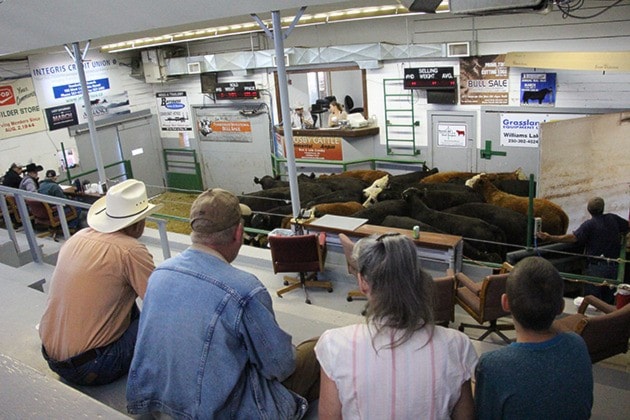Vanderhoof’s beef auctions’ first trot of the 2016 season rings close to 1,000 cattle at BC Livestock’s stockyard located just east of town on Aug. 12.
$38.5 million worth of cattle was sold last year at BC Livestock Producers Co-operative Association’s stockyard in Vanderhoof — one of four locations in the province including Kamloops, Williams Lake, and Okanagan Falls.
“We are strong in B.C. and Canada because we have more exotic cattle per capita,” said Decody Corbiere, yard manager and president of Sinkut Mountain Cattlemen’s Association. Exotic breeds, referring to those originating from continental Europe, tend to be bigger or more muscular, while British breeds include the more commonly known Angus and Hereford. Though predominantly British, the majority of Vanderhoof’s cows have some exotic mix, he added. “Cattle that came from Vanderhoof tend to perform well at the feedlot and yield a better carcass, finishing with the right weight and the right marbling.”
Some buyers from Alberta chose to purchase Vanderhoof beef, though they entail transportation costs, over cheaper-priced local cattle in their province, Corbiere said.
“That’s what drives it; we have cows with a good mixture of British and exotic bloodlines.”
Cattle processed in Vanderhoof’s auctions came from producers in the area including Vanderhoof, Prince George, Smithers, and Burns Lake.
At a rate of 200 animals per hour, the non-fed beef are mostly sold to ordered buyers who facilitate sales to feedlots or packing plants in Alberta and Kamloops, Corbiere explained. About 25,000 to 30,000 of cattle are normally sold in a year through the yard, which has the capacity to hold 2,500 animals during auctions.
While the first two auctions of the season feature mostly yearlings — cattle that are 15 to 16 months old — calves will be next going through the ring until the end of November, when bred cow sales begin.
For Dave Merz, who has been producing beef in Vanderhoof for 52 years, it’s an opportunity to observe cattle sale prices before purchasing calves for his backgrounding feedlot later this season. He finds this year’s pricing much lower than last season’s numbers, though they are climbing up slowly as the season continues.
“The trend now is Angus,” Merz said. “They grow faster at a lighter weight with less feed; the consumers don’t like a large roast.”
Merz has travelled to Australia and South America to study beef, growing his own hay to feed cattle. Some of his beef are sold in Vanderhoof while most are transported to Alberta for finishing.
He finds barley grain the best for fattening the animals.
“Argentina and Brazil used to have only grass fed, but they start to have more finishing feedlots,” he said. “‘Cause consumers want more fat, even when it’s more expensive.”
